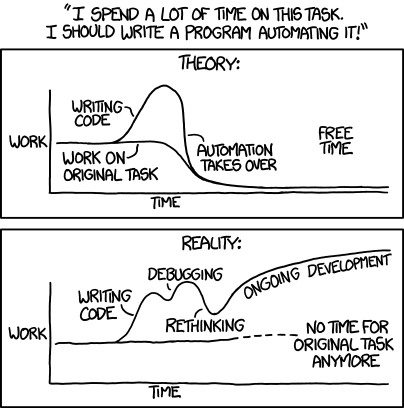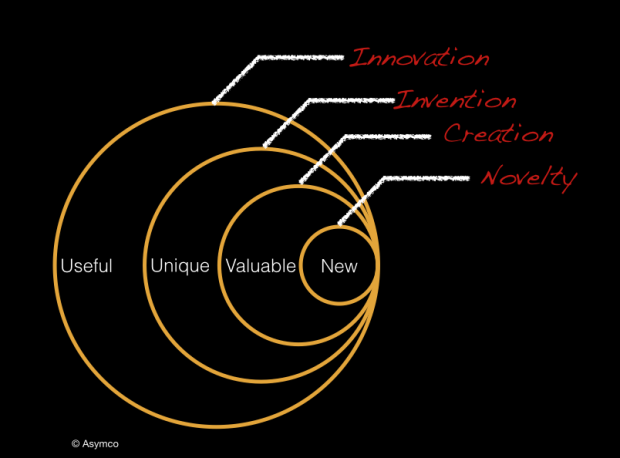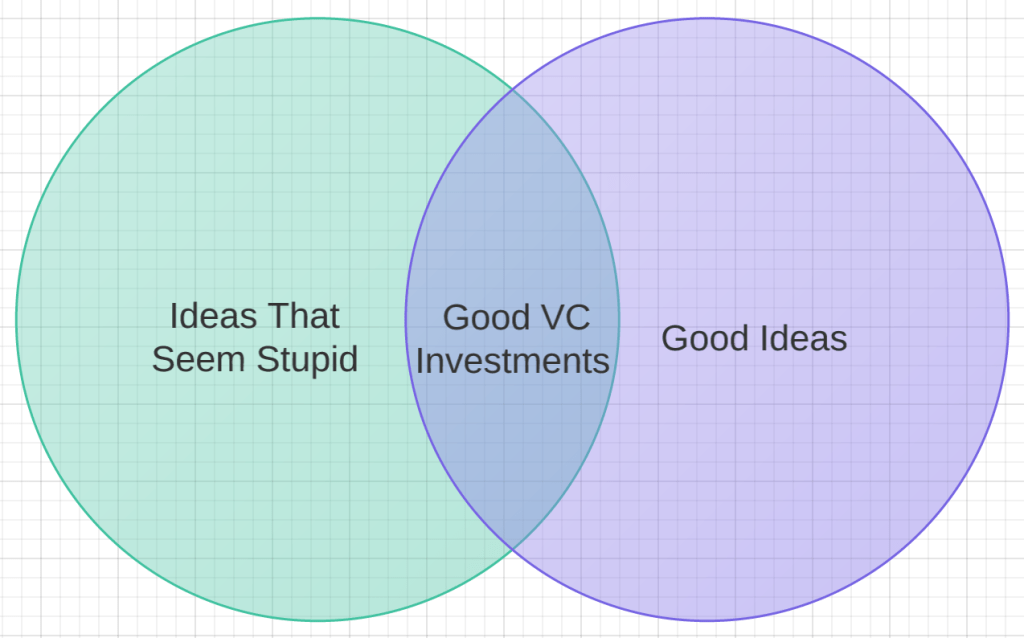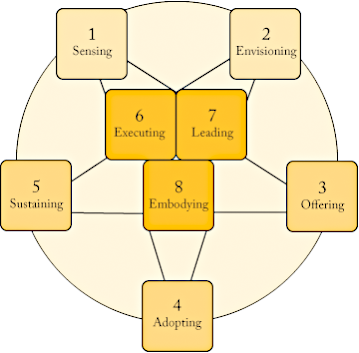Innovation is about finding a better way of doing something. Like many of the new development buzzwords (which many of them are over-used on many business documents), the concept of innovation originates from the world of business. It refers to the generation of new products through the process of creative entrepreneurship, putting it into production, and diffusing it more widely through increased sales. Innovation can be viewed as t he application of better solutions that meet new requirements, in-articulated needs, or existing market needs. This is accomplished through more effective products, processes, services, technologies, or ideas that are readily available to markets, governments and society. The term innovation can be defined as something original and, as a consequence, new, that “breaks into” the market or society.
Innoveracy: Misunderstanding Innovation article points out that there is a form of ignorance which seems to be universal: the inability to understand the concept and role of innovation. The way this is exhibited is in the misuse of the term and the inability to discern the difference between novelty, creation, invention and innovation. The result is a failure to understand the causes of success and failure in business and hence the conditions that lead to economic growth. The definition of innovation is easy to find but it seems to be hard to understand. Here is a simple taxonomy of related activities that put innovation in context:
- Novelty: Something new
- Creation: Something new and valuable
- Invention: Something new, having potential value through utility
- Innovation: Something new and uniquely useful
The taxonomy is illustrated with the following diagram.
The differences are also evident in the mechanisms that exist to protect the works: Novelties are usually not protectable, Creations are protected by copyright or trademark, Inventions can be protected for a limited time through patents (or kept secret) and Innovations can be protected through market competition but are not defensible through legal means.
Innovation is a lot of talked about nowdays as essential to businesses to do. Is innovation essential for development work? article tells that innovation has become central to the way development organisations go about their work. In November 2011, Bill Gates told the G20 that innovation was the key to development. Donors increasingly stress innovation as a key condition for funding, and many civil society organisations emphasise that innovation is central to the work they do.
Some innovation ideas are pretty simple, and some are much more complicated and even sound crazy when heard first. The is place for crazy sounding ideas: venture capitalists are gravely concerned that the tech startups they’re investing in just aren’t crazy enough:
Not all development problems require new solutions, sometimes you just need to use old things in a slightly new way. Development innovations may involve devising technology (such as a nanotech water treatment kit), creating a new approach (such as microfinance), finding a better way of delivering public services (such as one-stop egovernment service centres), identifying ways of working with communities (such as participation), or generating a management technique (such as organisation learning).
Theorists of innovation identify innovation itself as a brief moment of creativity, to be followed by the main routine work of producing and selling the innovation. When it comes to development, things are more complicated. Innovation needs to be viewed as tool, not master. Innovation is a process, not a one time event. Genuine innovation is valuable but rare.
There are many views on the innovation and innvation process. I try to collect together there some views I have found on-line. Hopefully they help you more than confuze. Managing complexity and reducing risk article has this drawing which I think pretty well describes innovation as done in product development:
8 essential practices of successful innovation from The Innovator’s Way shows essential practices in innovation process. Those practices are all integrated into a non-sequential, coherent whole and style in the person of the innovator.
In the IT work there is lots of work where a little thinking can be a source of innovation. Automating IT processes can be a huge time saver or it can fail depending on situation. XKCD comic strip Automation as illustrates this:

System integration is a critical element in project design article has an interesting project cost influence graphic. The recommendation is to involve a system integrator early in project design to help ensure high-quality projects that satisfy project requirements. Of course this article tries to market system integration services, but has also valid points to consider.
Core Contributor Loop (CTTDC) from Art Journal blog posting Blog Is The New Black tries to link inventing an idea to theory of entrepreneurship. It is essential to tune the engine by making improvements in product, marketing, code, design and operations.






5,658 Comments
Tomi Engdahl says:
Teknologia täydentää ihmisen kyvykkyyttä – Aivotutkijan mukaan teknologisten innovaatioiden on tarkoitus tehostaa yhteistyötä
https://www.dna.fi/yrityksille/blogi/-/blogs/teknologia-taydentaa-ihmisen-kyvykkyytta-aivotutkijan-mukaan-teknologisten-innovaatioiden-on-tarkoitus-tehostaa-yhteistyota?utm_source=facebook&utm_medium=social&utm_content=BUS-artikkeli-teknologia-taydentaa-ihmisen-kyvykkyytta-aivotutkijan-mukaan-teknologisten-innovaatioiden-on-tarkoitus-tehostaa-yhteistyota&utm_campaign=P_BUS_24-27-31_artikkelikampanja__&fbclid=IwZXh0bgNhZW0BMAABHeiVototTD53zXjHHbuYgWr2ZGCxiSqZn_O6_MFMVISxW8J94e1TMu49CA_aem_tBAHZ5r7VGv_0KswOjUEZg
Älyvaatteet avustavat puhevaikeuksista kärsiviä ihmisiä, älykello analysoi terveydentilaamme ja älysormus havaitsee juomaan ujutetun huumaavan aineen. Puhumattakaan siitä, että kuljemme joka paikkaan älypuhelin taskussa ja hyödynnämme työssämme päivittäin teknologisia apuvälineitä. Osaammeko enää elää ilman teknologiaa tai toisaalta – tarvitseeko meidän edes?
Tomi Engdahl says:
https://www.sciencealert.com/we-finally-know-what-turned-on-the-lights-at-the-dawn-of-time
Tomi Engdahl says:
https://hackaday.com/2024/07/13/particle-physics-on-a-small-affordable-pcb/
Tomi Engdahl says:
Time might be a mirage created by quantum physics, study suggests
News
By Ben Turner published July 11, 2024
Physicists have struggled to understand the nature of time since the field began. But a new theoretical study suggests time could be an illusion woven at the quantum level.
https://www.livescience.com/physics-mathematics/quantum-physics/time-might-be-a-mirage-created-by-quantum-physics-study-suggests
Tomi Engdahl says:
https://www.sciencealert.com/scientists-identify-a-speech-trait-that-foreshadows-cognitive-decline
Tomi Engdahl says:
Manijeh Razeghi: The curious life of communication physics
Professor Manijeh Razeghi of Northwestern University, USA, is a pioneer in the world of semiconductors and optoelectronic devices. She was central to the optical fibre telecommunication revolution in the 1980s and 1990s – an integral part of the subsequent information age. In this interview with Research Outreach, Razeghi reveals why she is just as passionate and curious now as when she was as a young girl wondering how the world worked.
https://researchoutreach.org/articles/manijeh-razeghi-the-curious-life-of-communication-physics/
Tomi Engdahl says:
https://recordinghistory.org/technology/history-of-the-technologies-for-recording-music-and-sound-an-overview/the-rise-of-the-8-track/
Tomi Engdahl says:
https://hackaday.com/2024/07/13/its-not-unsual-to-love-hacking/
Tomi Engdahl says:
Research team creates process to grow sub-nanometer transistors
This could lead to the development smaller, yet more powerful electronic devices
https://www.techspot.com/news/103696-research-team-creates-process-grow-sub-nanometer-transistors.html
WHY IT MATTERS: Moore’s Law might not be dead after all. A new technique using nanomaterials can further miniaturize transistors, allowing fab plants to pack more of them on each chip. This research opens up new possibilities for creating advanced semiconductor devices with features smaller than current lithography techniques allow.
Integrated devices based on two-dimensional semiconductors exhibit excellent electrical properties even when thinned to atomic-scale thickness, making them promising candidates for creating ultra-thin, high-performance electronic devices. A separate study indicates that these 2D logic circuits are promising candidates for the post-Moore’s Law era.
However, developing manufacturing processes for integrated circuits based on 2D designs has faced significant hurdles. Integrating 2D materials into devices without damaging their delicate structure is extremely difficult, and achieving consistent large-scale production of high-quality 2D materials is also highly challenging.
Another problem is that current lithography and fabrication techniques don’t work at such small scales. In conventional semiconductor fabrication processes, reducing the gate length below a few nanometers is impossible due to the limitations of lithography resolution.
The team could transform the existing 2D semiconductor into a 1D MTB by controlling the crystal structure at the atomic level. These 1D metallic structures can serve as gate electrodes in ultra-miniaturized transistors.
“The 1D metallic phase achieved through epitaxial growth is a new material process that can be applied to ultra-miniaturized semiconductor processes,” said Director JO Moon-Ho. “It is expected to become a key technology for developing various low-power, high-performance electronic devices in the future.”
Tomi Engdahl says:
Katri Saarikiven kolumni: Käytämme teknologiaa tavalla, joka tuhoaa kyvyn laadukkaaseen ajatteluun ja elämään
Nykyihminen käyttää teknologiaa tavalla, joka heikentää kykyä laadukkaaseen ajatteluun, Saarikivi kirjoittaa.
https://yle.fi/a/74-20090254
Tutkimusten mukaan teknologia vaikuttaa monin tavoin tarkkaavuuteen.
Oikeastaan kyse oli tarkkaavuudesta.
Tutkimusten mukaan teknologia vaikuttaa monin tavoin tarkkaavuuteen.
Ensin hyvät uutiset: netinkäyttö ei näyttäisi heikentävän, vaan jopa parantavan, lyhytkestoista tarkkaavuutta. Sen sijaan tietokoneella vietetty aika ja lyhyisiin nettivideoihin koukuttuminen ovat yhteydessä pitkäjänteisen keskittymisen hankaluuksiin.
Moni valittaakin, että nykyään kirjaan tai elokuvaan keskittyminen on hankalaa. Kuin itsestään käsi alkaa hamuamaan puhelinta.
Väittäisin, että digitaalisuuden kaappaama tarkkaavuus pääsee myös yhä harvemmin vapaasti harhailemaan.
Kummallakin on vaikutuksia paitsi aikaansaavuuteen, myös luovuuteen.
Aivotutkimuksen mukaan ajattelun harhailuun liittyvän aivoverkoston yhteistyö tarkkaavuutta säätelevien verkostojen kanssa on eräänlainen luovuuden aivoperusta. Onkin havaittu, että älypuhelinaddikteilla nämä aivoverkostot toimivat heikommin luovan ongelmanratkaisun aikana, ja myös suoriutuminen luovuustehtävissä ontuu.
Syy ei kuitenkaan ole lähtökohtaisesti teknologian, vaan ihmisen.
Nykyihminen käyttää usein teknologiaa tavalla, joka heikentää kykyä laadukkaaseen ajatteluun.
Moni ahmii digikarkkia niin paljon, että virikkeittä oleminen tai hitaampi mielihyvä maistuu puulta.
Töissä päivät kuluvat yhteistuumin luoduissa etäpalaveriputkissa, ja harkitsematta käyttöönotetun ohjelmakavalkadin kilkutuksiin reagoidessa.
Parisuhteissa virkistävät keskustelut vaihtuvat puhelimien takaa keskenjäävien lauseiden muminaan.
Vähän sama kuin olisi keksitty vasara, ja naulojen sijaan hakkaisimme sillä iloisesti peukaloa. Ja ihmettelisimme yhteen ääneen, miten outoa on, kun nykyään peukkua koko ajan kolottaa, eivätkä rakennukset valmistu.
Onko tämä monin tavoin keskittymiskyvytön ja luovuusköyhä elämä sellaista, jota haluamme elää?
Ehkä teknologian väärinkäyttö selittää osin työuupumusepidemiaa sekä sitä, että esimerkiksi kunnolla mullistavien tieteellisten löydösten ja patenttien määrä on tasaisessa laskussa.
Myös politiikassa inspiroivia visioita on saanut kovin pitkään Suomessa odotella, kirjoittaa Esa Mäkinen oivallisessa kolumnissaan.
No, ei hätäpäivää. Tuoreen tutkimuksen mukaan kielimalli päihittää ihmiset luovuustesteissä.
Yksi ratkaisu on siis ulkoistaa tämäkin ajattelu koneille.
Mutta mitä tapahtuu, jos emme käytä enää aivojamme oivaltamiseen ja ideointiin, tai jos hyväksymme teknologian runteleman keskittymiskyvyn?
Useimpien mielestä keksiminen on kivaa puuhaa.
Ajatusten harhailu liittyy myös rentoutumiseen ja sitä kautta hyvinvointiin, ja sitä nykyihminen tarvitsee mielestäni rutkasti enemmän, ei vähempää.
Pitkäjänteisellä keskittymisellä saavutamme puolestaan elämässä asioita, joilla on merkitystä.
Tällä hetkellä mietitään kuumeisesti, miten tekoälyä olisi järkevin käyttää. Kyse on myös siitä, minkälaista elämää haluamme elää.
Mielestäni paras tapa olisi sellainen, että se parantaisi ihmisen hyvinvointia ja kykyä ongelmanratkaisuun.
Olisi siis tarve pikaisesti miettiä, onko tämä monin tavoin keskittymiskyvytön ja luovuusköyhä elämä sellaista, jota haluamme elää?
Tomi Engdahl says:
https://tekniikanmaailma.fi/lehti/17b-2023/elektroniputki/#Echobox=1721348587
Tomi Engdahl says:
New Chinese drone can fly as long as the sun shines — solar-powered device with 200mm wingspan weighs record-breaking 4.21g
https://www.tomshardware.com/tech-industry/new-chinese-drone-can-fly-as-long-as-the-sun-shines-solar-powered-device-with-200mm-wingspan-weighs-record-breaking-421g?utm_medium=social&utm_source=facebook.com&utm_content=tomsguide&utm_campaign=socialflow&fbclid=IwZXh0bgNhZW0CMTEAAR2gxr8WlCKOtTrvUOHEhDvlf7CG9iRSycQfblckF-UVyv975AKHt71SbsM_aem_njxgvVC4uUppEeZeOz5Dhw
Electrostatic motor made this super-light self-powered drone possible.
Beijing scientists have developed what they claim is the world’s smallest and lightest solar-powered drone. One of the key milestones this 4.21g device with its 200mm wingspan has achieved is being able to fly non-stop during daylight. CoulombFly is also remarkable for being about 10 times smaller and 600 times lighter than the previous smallest sunlight powered drone, reports IEEE Spectrum.
Tomi Engdahl says:
Scientists found that inhibiting the protein IL-11 extended mice lifespans by 25%: https://ie.social/4yM3L
Tomi Engdahl says:
VTT:llä saa mokata, sanoo toimitusjohtaja Antti Vasara, koska erehdyksessä voi olla innovaation siemen
VTT:n toimitusjohtaja Antti Vasaran mukaan mokaaminen on opettavaista ja kuuluu tutkijan työhön, ja siksi sitä ei saa pelätä. Toimitusjohtaja itse mokaa kerran tunnissa, ja yksi erhe harmittaa edelleen
https://www.op-media.fi/johtaminen/vttlla-saa-mokata-sanoo-toimitusjohtaja-antti-vasara/?cmpid=….facebook%20instagram%20audience_network%20messenger.social.VTT%3All%C3%A4%20saa%20mokata%2C%20sanoo%20toimitusjohtaja%20Antti%20Vasara_Copy3%20%2F%20Johtajat%20%2F%20Yritysel%C3%A4m%C3%A4%20%2F%2030-55v.%20%2F%20Korjattu.&fbclid=IwZXh0bgNhZW0BMAABHZ-HI5jYhFbiunGcAt6vdIK2LbGLaSf4gAomKtfbyUOAgIHbO6rz7e2NDQ_aem_nA2L4UaPidfQo7F0RN7R0w&utm_medium=paid&utm_source=fb&utm_id=6308118096231&utm_content=6583553007431&utm_term=6375392635831&utm_campaign=6308118096231
Tomi Engdahl says:
Suomalaiskeksijän mullistava ioni-ilmanpuhdistus hämmästytti Nasaa, mutta patentti hylättiin Aku Ankan takia
Helena Raunio26.7.202422:05HISTORIA
Veikko Ilmasti on yli 70 vuoden keksijänurallaan kokenut velkaantumisen kantapään kautta.
https://www.tivi.fi/uutiset/suomalaiskeksijan-mullistava-ioni-ilmanpuhdistus-hammastytti-nasaa-mutta-patentti-hylattiin-aku-ankan-takia/ba11a2b1-7416-42ce-ba8b-a0a29c9178fd
Tomi Engdahl says:
4,000 Meters Below Sea Level, Scientists Have Found the Spectacular ‘Dark Oxygen’
What if it could solve all of our energy problems?
https://www.popularmechanics.com/science/environment/a61679456/scientists-find-dark-oxygen-deep-below-sea-level/
Tomi Engdahl says:
Quantum computing breakthrough achieved with on-chip pulse generator
The existing methods for readout and manipulation of qubits are both cost-intensive and cumbersome.
https://interestingengineering.com/science/quantum-computing-cryogenic-pulse-generator
Tomi Engdahl says:
MIT researchers create a super-fast, super-tough, super-slidey transistor and claim that in ’10 to 20 years from now could change the world’
News
By Nick Evanson published 29 July 2024
The ferroelectric material transistor could be used to make NVMe SSDs last a whole lot longer.
https://www.pcgamer.com/hardware/ssds/mit-researchers-create-a-super-fast-super-tough-super-slidey-transistor-and-claim-that-in-10-to-20-years-from-now-could-change-the-world/
Tomi Engdahl says:
The chemical roots of consciousness
Mind and consciousness have a physical basis
https://iai.tv/articles/consciousness-drives-evolution-auid-2889
Tomi Engdahl says:
Surprise Hair Loss Breakthrough: Sugar Gel Triggers Robust Regrowth
https://www.sciencealert.com/surprise-hair-loss-breakthrough-sugar-gel-triggers-robust-regrowth
Tomi Engdahl says:
https://www.autodesk.com/products/fusion-360/blog/led-journey-to-pcb-stardom/
Tomi Engdahl says:
https://bitwise.fi/kotoskisa/
Tomi Engdahl says:
https://www.tieteessatapahtuu.fi/kategoriat/arkistosta/82001/minkalaiset-kulttuurit-tuottavat-innovaatioita
Tomi Engdahl says:
Capturing carbon by mimicking haemoglobin
Carbon-capture technology inspired by blood cells is being used in applications from human space travel to the creation of bioplastics.
https://www.nature.com/articles/d42473-024-00102-6?utm_source=facebook&utm_medium=social&utm_campaign=APSR_FOCAL_AWA1_GL_PCFU_CFULF_CCL-ZC-AP24&fbclid=IwZXh0bgNhZW0BMAABHbX6zOOY69p4qAN_NbvOGHHrpz_9ZmDHmd5iVQ8ZM05cf3sm9AZvG3OTYA_aem_r2rR9w9seJ77UFem47_h_A&utm_id=120209276225960572&utm_content=120209341956150572&utm_term=120209341956170572
By mimicking how blood takes up and releases carbon dioxide, researchers in Japan have developed a technology that traps and releases carbon dioxide using a mere fraction of the energy of conventional carbon-capture systems. It is being developed as the basis of a practical system for recycling carbon dioxide into products ranging from sustainable bioplastics to green fuels.
Jelly-like materials known as hydrogels that can capture carbon could overcome a key limitation of conventional carbon capture for combating climate change, says Yu Hoshino, who leads the project at Kyushu University in Fukuoka. The project is a part of Japan Science and Technology Agency’s Program on Open Innovation Platforms for Industry–Academia Co-creation (COI-NEXT).
Hoshino’s hydrogels were inspired by the body’s energy-efficient system for capturing the carbon dioxide our cells produce. “Our body has a very sophisticated molecular system for capturing and eliminating carbon dioxide without using energy,” he says.
The basis of this system is haemoglobin, the red-blood-cell protein best known for carrying oxygen.
Hoshino has adopted this amine switching behaviour in a practical, scalable, carbon-capture system amenable to industrial use. “We use synthetic hydrogel nanoparticles that respond to temperature,” says Hoshino. “They’re much cheaper and more stable than using a protein.”
Hydrogels are composed of crosslinked water-attracting polymers and water. “If we incorporate an amine in the hydrogel polymer, those nanoparticles should have a high pH and good carbon capture,” says Hoshino.
in the hydrogel the carbon-dioxide-releasing transition occurs at just 50–60 °C
Tomi Engdahl says:
https://tekniikanmaailma.fi/lehti/9a-2024/kasvihuoneilmio/?utm_term=Autofeed&utm_medium=Social&utm_source=Facebook&fbclid=IwZXh0bgNhZW0CMTEAAR2FdcOiGy3vFtvJTd5ufq1DA_mLgXGc99FOmOdnVKCPzxhP1UO3TMt_QWI_aem_ajlhTNHRLVGXsKHevdXJnw#Echobox=1722732500
Tomi Engdahl says:
Scientists Connect 16 Mini Brains Made of Human Tissue to Create a “Living Computer”
It’s like a 21st century version of Frankenstein’s monster.
https://futurism.com/neoscope/mini-brains-human-tissue-living-computer?fbclid=IwZXh0bgNhZW0CMTEAAR2-X1Nv5Oqb6njSGH0zK67dRgNBi2GkhUGvu4jMcF_Bo3R3xq8mZMfQFtE_aem_Cts9rmevTlbvUHiLRM4Y8g
Switzerland-based startup FinalSpark claims to have built a unique computer processor made from 16 mini brains made from human brain tissue, Tom’s Hardware reports — and they are positioning this “living computer” as an alternative to silicon-based computing.
And now, other researchers can remotely access the startup’s biocomputer, the Neuroplatform, to conduct studies on, say, artificial intelligence, which typically requires enormous resources.
“One of the biggest advantages of biological computing is that neurons compute information with much less energy than digital computers,” FinalSpark scientist and strategic advisor Ewelina Kurtys wrote in a company blog post earlier this month. “It is estimated that living neurons can use over 1 million times less energy than the current digital processors we use.”
Tomi Engdahl says:
These Earbuds Know When You’re Drowsy
UC Berkeley researchers developed earbuds that detect drowsiness by monitoring brain activity via EEG and classifying the patterns with AI.
https://www.hackster.io/news/these-earbuds-know-when-you-re-drowsy-04618e44d028
Tomi Engdahl says:
Wifistä sähköä: uusi keksintö heittää hyvästit akuille ja virtajohdoille
31.7.202411:00|päivitetty31.7.202411:00
Laitteen akun tyhjeneminen tai verkkovirran katkeaminen ei enää haittaa, mikäli teknologiaa aletaan ottaa käyttöön. Wifin avulla tuotettua sähköä voisi kuitenkin hyödyntää vain tietyissä laitteissa.
https://www.mikrobitti.fi/uutiset/wifista-sahkoa-uusi-keksinto-heittaa-hyvastit-akuille-ja-virtajohdoille/4ae56c74-18c3-46d9-8187-2735cec80a3c
Osa sähkölaitteista ei tulevaisuudessa välttämättä enää tarvitse akkua tai edes virtajohtoa. Tarvittava sähkövirta voidaan antaa laitteelle perinteisten menetelmien sijaan wifi-verkon kautta langattomasti.
Tomi Engdahl says:
https://etn.fi/index.php/13-news/16459-mullistavassa-natriumakussa-ei-ole-anodia
Tomi Engdahl says:
Tiede todistaa: Tämä ruokavalio jopa pysäyttää vanhenemisen
Vegaaniruokavaliota noudattamalla voi hidastaa vanhenemista, tutkitusti.
https://www.iltalehti.fi/elintavat/a/72a8ed8d-9137-42c6-9616-5de9eeea1136
Vegaaniruokavalio voi hidastaa kehon biologista ikääntymistä hyvin lyhyessä ajassa.
Vegaaniruokavaliota noudattavien paino putosi keskimäärin kaksi kiloa enemmän kuin sekasyöjillä.
Vegaani on kasvissyöjä, joka ei käytä ravinnossaan mitään eläinperäisiä raaka-aineita.
Vegaaniruokavalion noudattaminen voi hidastaa biologista ikääntymistä jo hyvin lyhyessä ajassa, selviää tuoreesta tutkimuksesta.
Tutkimuksessa seurattiin 22 identtistä kaksosparia kahdeksan viikon ajan. Toinen kaksosista noudatti testijaksolla vegaanista ruokavaliota, toinen sekaruokavaliota.
Tutkimus on julkaistu BMC Medicine -tiedejulkaisussa.
Vegaaniruokavaliota noudattavien epigeneettinen eli biologinen ikä laski kahdeksan viikon tutkimusjakson aikana merkittävästi, kun taas sekasyöjien ei. Ikääntymisen hidastumista oli vegaaniruokavaliota noudattavien ryhmässä havaittavissa muun muassa sydämessä ja maksassa sekä hormonitoiminnassa ja aineenvaihdunnassa.
Unveiling the epigenetic impact of vegan vs. omnivorous diets on aging: insights from the Twins Nutrition Study (TwiNS)
https://bmcmedicine.biomedcentral.com/articles/10.1186/s12916-024-03513-w
Results
Distinct responses were observed, with the vegan cohort exhibiting significant decreases in overall epigenetic age acceleration, aligning with anti-aging effects of plant-based diets. Diet-specific shifts were noted in the analysis of methylation surrogates, demonstrating the influence of diet on complex trait prediction through DNA methylation markers. An epigenome-wide analysis revealed differentially methylated loci specific to each diet, providing insights into the affected pathways.
Conclusions
This study suggests that a short-term vegan diet is associated with epigenetic age benefits and reduced calorie intake. The use of epigenetic biomarker proxies (EBPs) highlights their potential for assessing dietary impacts and facilitating personalized nutrition strategies for healthy aging. Future research should explore the long-term effects of vegan diets on epigenetic health and overall well-being, considering the importance of proper nutrient supplementation.
Tomi Engdahl says:
https://etn.fi/index.php/13-news/16464-uusi-materiaali-pidentaeae-litiumakkujen-kaeyttoeikaeae
Tomi Engdahl says:
Tutkimus: Hyönteiset syövät vähemmän lehtiä, jotka ovat öisin keinovalossa – syy on kuitenkin epäselvä
https://tekniikanmaailma.fi/hyonteiset-syovat-vahemman-lehtia-jotka-ovat-oisin-keinovalossa-syy-on-kuitenkin-epaselva/
Tomi Engdahl says:
https://tekniikanmaailma.fi/ajatteleminen-voi-jopa-sattua-ja-siksi-siita-tulisi-palkita-tutkimus-kertoo/
Tomi Engdahl says:
Nickel-63: US firms plan nuclear battery with 50-year lifespan to counter China
The energy derived from nuclear batteries does not rely on chain reactions, as is the case in nuclear power plants.
https://interestingengineering.com/energy/us-firms-nuclear-battery-nickel-63?utm_source=facebook&utm_medium=article_image
Two United States companies have entered into a strategic collaboration to develop a small nuclear battery – named Nickel 63 – to narrow the gap with China.
According to the announcement made by Kronos Advanced Technologies and Yasheng Group the nuclear battery will have an extended lifespan of up to 50 years.
It can be used to address critical energy storage needs across various sectors, including medical devices, remote sensing, space exploration, and of course military use for various purposes.
Tomi Engdahl says:
https://etn.fi/index.php/13-news/16472-fluorin-poistaminen-tekee-litiumakusta-kestaevaemmaen
Tomi Engdahl says:
Ajatteleminen voi jopa sattua, ja siksi siitä tulisi palkita, tutkimus kertoo
https://tekniikanmaailma.fi/ajatteleminen-voi-jopa-sattua-ja-siksi-siita-tulisi-palkita-tutkimus-kertoo/
Henkinen ponnistelu voi aiheuttaa epämiellyttäviä tuntemuksia, ilmenee tuoreesta tutkimuksesta. Toisin sanoen ajatteleminen voi todellakin sattua.
Tutkimusartikkeli aiheesta on julkaistu Psychological Bulletin -tiedelehdessä.
Tutkijat havaitsivat, että mitä suurempi henkinen ponnistus ihmisellä oli, sitä epämiellyttävämpiä tuntemuksia hän koki.
Tutkijat muistuttavat, että siinä missä opiskelijoita tai työntekijöitä kannustetaan ajatteluun, on hyvä tutkimustuloksen valossa muistaa, että yleisesti ihmiset eivät pidä henkisestä ponnistelusta.
”Tuloksemme osoittavat, että henkinen ponnistelu tuntuu epämiellyttävältä monenlaisissa väestöryhmissä ja tehtävissä”, sanoo tutkimuksen pääkirjoittaja, hollantilaisen Radboudin yliopiston Erik Bijleveld tiedotteessa.
”Ammattilaisten, kuten insinöörien ja opettajien, on tärkeää pitää tämä mielessä, kun he suunnittelevat tehtäviä, työkaluja, käyttöliittymiä, sovelluksia, materiaaleja tai ohjeita. Kun ihmisiltä vaaditaan huomattavaa henkistä ponnistelua, on varmistettava, että heitä tuetaan tai palkitaan heidän ponnisteluistaan.”
Tutkijoiden huomion kiinnitti erityisesti havainto, että vaikka henkisen ponnistelun ja kielteisten tunteiden välinen yhteys oli edelleen merkittävä, se oli vähemmän selvä Aasiassa tehdyissä tutkimuksissa kuin Euroopassa tai Pohjois-Amerikassa tehdyissä tutkimuksissa.
Havainto sopii yhteen yleisen ajatuksen kanssa, että henkisen ponnistelun vastahakoisuus voi riippua ihmisten oppimishistoriasta. Aasian maiden lukiolaisilla on taipumus käyttää enemmän aikaa koulutyöhön kuin eurooppalaisilla tai pohjoisamerikkalaisilla opiskelijoilla, ja siksi he saattavat oppia kestämään suurempaa henkistä rasitusta jo varhain elämässään, tutkijat arvioivat.
Tutkijoiden mukaan tärkein kuitenkin on se havainto, että huolimatta henkisesti haastavien tehtävien vastenmielisestä luonteesta ihmiset osallistuvat niihin vapaaehtoisesti.
”Miksi esimerkiksi miljoonat ihmiset pelaavat shakkia? Ihmiset saattavat oppia, että henkisen ponnistelun käyttäminen joihinkin tiettyihin toimintoihin johtaa todennäköisesti palkkioon”, Bijleveld sanoo.
Tomi Engdahl says:
https://www.uusiteknologia.fi/2024/08/15/kvanttipumpuista-apua-molekyylielektroniikkaan/
Tomi Engdahl says:
Imagine wi-fi speeds at 100x current rates. Using optical or infrared light, such blindingly fast data rates could be possible. And Caltech researchers have developed a smart surface (called a metasurface) that could enable next-generation electronics to bring wireless technologies into the vast bandwidths provided by optical frequencies.
Optical Metasurfaces Shine a Light on Li-Fi, Lidar Tiny, tunable “mirrors” could advance communications, sensing, and more
https://spectrum.ieee.org/lifi-lidar-metasurface-applications?share_id=8377587&socialux=facebook&utm_campaign=RebelMouse&utm_content=IEEE+Spectrum&utm_medium=social&utm_source=facebook&fbclid=IwZXh0bgNhZW0CMTEAAR3D-Nu364LU8eClZz-stH6h4dFgJt3k0QXnbI7QZ018WaxfrFUHMwEfZKw_aem_dEdqZ3WzYO1o07OisBVUcw
Tomi Engdahl says:
https://etn.fi/index.php/13-news/16480-uusi-anodirakenne-tuo-akkuun-10-kertaisesti-kapasiteettia
Tomi Engdahl says:
Groundbreaking Brain Chip Allows Man With ALS to “Speak” Again
This is next level.
https://futurism.com/neoscope/als-bci-brain-chip-speak
Tomi Engdahl says:
Is THIS how the world will end? 50% chance the Andromeda galaxy will collide with Milky Way
https://www.dailymail.co.uk/sciencetech/article-13742825/Andromeda-galaxy-collide-Milky.html
Tomi Engdahl says:
Time’s Arrow Within Glass Appears To Go In Both Directions, Raising Huge Questions
The second law of thermodynamics would like a chat.
https://www.iflscience.com/times-arrow-within-glass-appears-to-go-in-both-directions-raising-huge-questions-75551
Tomi Engdahl says:
How Base 3 Computing Beats Binary
By
Stephen Ornes
August 9, 2024
Long explored but infrequently embraced, base 3 computing may yet find a home in cybersecurity.
https://www.quantamagazine.org/how-base-3-computing-beats-binary-20240809/
Three, as Schoolhouse Rock! told children of the 1970s, is a magic number. Three little pigs; three beds, bowls and bears for Goldilocks; three Star Wars trilogies. You need at least three legs for a stool to stand on its own, and at least three points to define a triangle.
The number 3 also suggests a different way of counting. Our familiar base 10 decimal system uses the 10 digits from zero to 9. Binary, our digital lingua franca, represents numbers using only the two digits zero and 1.
But mathematicians have long explored counting in threes. Consider, for example, base 3, or ternary, which uses three digits. The standard convention is to use the digits zero, 1 and 2.
Tomi Engdahl says:
Super strict 900 calorie diet offered by NHS can reverse type 2 diabetes
The NHS soup and shake diet can beat type 2 diabetes, research suggests
https://www.ladbible.com/news/health/nhs-uk-type-2-diabetes-reverse-food-drink-806497-20240806
Tomi Engdahl says:
Capturing carbon by mimicking haemoglobin
Carbon-capture technology inspired by blood cells is being used in applications from human space travel to the creation of bioplastics.
https://www.nature.com/articles/d42473-024-00102-6
Tomi Engdahl says:
Nuclear fusion game-changer: New method can cut reactor design time by decade
The team replaced a portion of the traditional thermal hydraulic and neutronics simulations with a trained machine learning model.
https://www.hackster.io/news/an-ai-assistant-with-an-attitude-91fb590fec11
Tomi Engdahl says:
https://www.earth.com/news/lightning-sparks-the-discovery-of-a-new-electromagnetic-wave/
Tomi Engdahl says:
US achieves superconductor breakthrough, creates new material for quantum leap
The researchers were able to create high-quality low-loss microwave resonators, critical components of quantum computing.
https://interestingengineering.com/science/us-achieves-superconductor-breakthrough-quantum-leap
Tomi Engdahl says:
MIT develops low-cost, high-energy batteries using disordered rock salt cathodes
The new material family primarily comprises manganese, an earth-abundant element less expensive than nickel and cobalt.
https://interestingengineering.com/energy/mit-battery-rock-salt-cathode
Tomi Engdahl says:
Just One All-Nighter Can Rewire The Brain And Reverse Feelings Of Depression For Days
Sleepless nights are giving scientists clues that could help them develop new
https://www.iflscience.com/just-one-all-nighter-can-rewire-the-brain-and-reverse-feelings-of-depression-for-days-71630?fbclid=IwY2xjawE5on5leHRuA2FlbQIxMQABHZjnLKUQgclLT2dLN2Q4l-YWta3ApOjFpUJcfbCCoKiBswVnlIgtAi4Nug_aem_RiHcOlo4iMEFJcCuOV8bEg